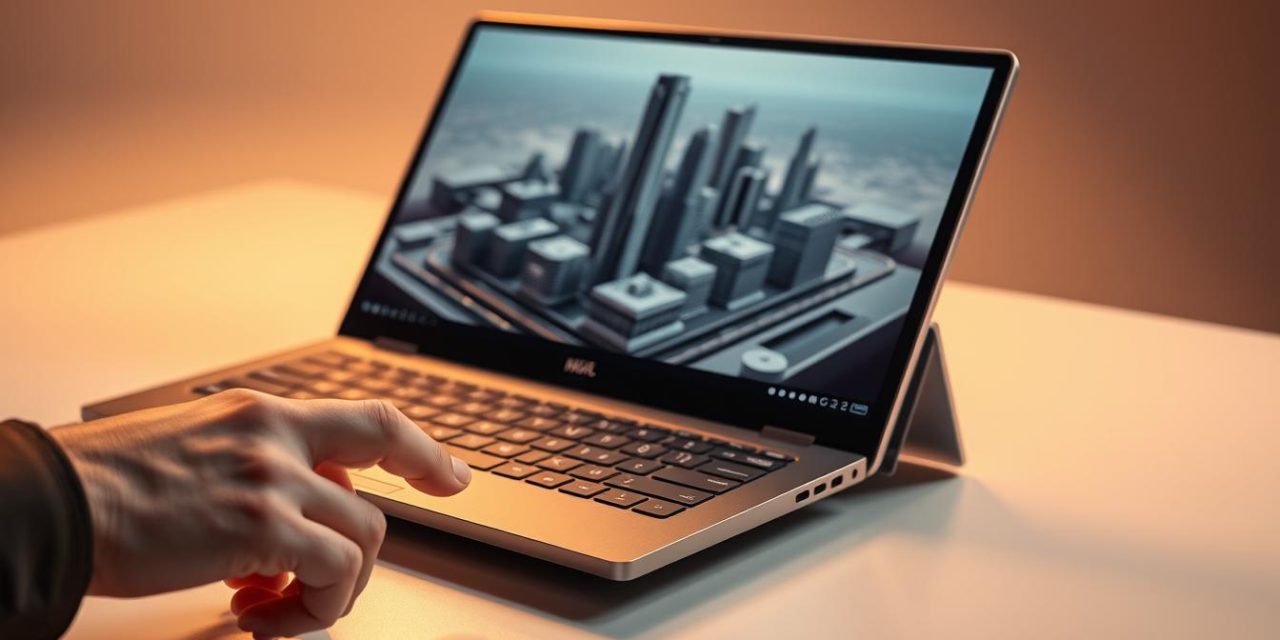Did you know professionals using specialized laptops complete complex 3D renders twice as fast as those relying on standard devices? These high-performance systems aren’t just upgrades—they redefine what’s possible for engineers, designers, and data scientists working remotely.
Modern workflows demand more than basic portability. Applications like CAD and AI-driven analytics require industrial-grade graphics and desktop-level processing. Traditional laptops often struggle with thermal throttling or inadequate memory, but purpose-built solutions eliminate these barriers.
What sets these machines apart? Certified components ensure compatibility with niche software, while advanced cooling maintains stability during marathon sessions. Security features like biometric authentication protect sensitive projects, giving freelancers and corporate teams alike peace of mind.
Battery technology has also evolved. Engineers can now run simulations for hours without hunting for outlets—a game-changer for airport layovers or client-site meetings. This blend of endurance and raw capability makes these tools indispensable for today’s dynamic work culture.
Table of Contents
Key Takeaways
- Specialized hardware accelerates complex tasks like 3D rendering and data analysis
- Certified components ensure reliability with professional software ecosystems
- Advanced thermal designs prevent slowdowns during intensive workloads
- Enterprise-grade security protects intellectual property on the go
- Long-lasting batteries support uninterrupted productivity away from desks
- Informed selection balances performance needs with budget considerations
Introduction to Mobile Workstations
When café tables become temporary offices and airport lounges transform into project hubs, standard laptops reveal their limitations. Specialized systems bridge the gap between raw power and real-world reliability for today’s on-the-move experts.
Defining Modern Professional Tools
These aren’t your average laptops. Engineered for precision, they combine ISV-certified components with industrial-grade cooling systems. Architects manipulate 4K building models without lag, while video editors scrub through 8K timelines smoothly—even during cross-continental flights.
Key differentiators include:
- Military-grade durability testing for rough commutes
- Error-correcting memory that prevents data corruption
- GPUs validated for AutoCAD, SOLIDWORKS, and Maya
The Professional Advantage
Freelancers and corporate teams alike benefit from built-in security like fingerprint readers and TPM chips. “My clients trust me with proprietary designs—I can’t risk breaches,” notes Paris-based engineer Élise Dubois.
Battery innovations deserve equal attention. Unlike consumer models that throttle performance off-grid, these systems maintain 90% capability for 6+ hours. Combine this with 24/7 enterprise support contracts, and you’ve got a tool that protects both productivity and peace of mind.
Key Features of Top Mobile Workstations

Visual precision separates professional tools from consumer devices. Today’s elite systems combine pixel-perfect displays with engineering that sustains peak performance across unpredictable work environments. Let’s explore what makes these devices indispensable for detail-oriented tasks.
Cutting-edge Display Technology and Design
4K OLED screens now deliver 1,000,000:1 contrast ratios—essential for spotting subtle gradients in architectural renders. HP’s DreamColor panels achieve Delta E , matching studio monitor quality. Dell’s 16-inch UltraSharp touchscreens offer 120Hz refresh rates, eliminating motion blur during 3D model rotations.
Ergonomic designs matter too. Slim bezels maximize screen real estate without increasing chassis size. Anti-glare coatings maintain readability under airport lighting, while matte finishes reduce fingerprint smudges during client presentations.
Robust Processing and Graphics Performance
Intel’s Core Ultra 9 processors handle 8K video timelines alongside machine learning algorithms. Paired with Nvidia RTX 3500 Ada GPUs, these configurations render complex simulations 40% faster than previous generations. Thermal innovations like vapor chamber cooling keep noise below 35dB—quieter than most office backgrounds.
Battery Life and Portability Essentials
Advanced power management extends runtime to 14 hours for CAD workflows. One engineer reported, “I finalized a bridge design during a Paris-to-Tokyo flight without plugging in.” Magnesium alloy frames withstand baggage checks while shaving 300g off traditional weights.
Quick-charge technology adds 6 hours of use in 30 minutes—perfect for café pit stops between meetings. These features ensure professionals stay productive wherever inspiration strikes.
Performance and Graphics – RTX 3000 Ada & Nvidia RTX
What separates groundbreaking design concepts from pixelated drafts? The answer lies in GPU architecture that keeps pace with creative ambition. Nvidia RTX 3000 Ada GPUs redefine visual computing, offering professionals unprecedented control over complex workflows.
Understanding RTX 3000 Ada Technology
Built on third-generation RT cores, the 3000 Ada architecture delivers 2.5x faster ray tracing than previous models. This means architects see sunlight interact with glass facades in real time, while animators preview subsurface scattering instantly. With configurations from 8GB to 16GB GDDR6 memory, these GPUs handle 8K textures without breaking stride.
Key innovations include:
- AI-accelerated denoising for cleaner renders
- Error-correcting memory for mission-critical tasks
- Dynamic voltage scaling to balance power/performance
Benefits of Nvidia RTX in Professional Tasks
“My Maya scenes load 40% faster since upgrading,” reports Lyon-based VFX artist Camille Renault. The Nvidia RTX 3000 series isn’t just about raw power—certified drivers ensure flawless operation in Autodesk and Adobe ecosystems. Machine learning enhancements automate repetitive tasks like photo retouching or simulation setup.
Real-time ray tracing transforms client presentations. Designers demonstrate material properties under varying lighting conditions without pre-rendering delays. Combined with 14-hour battery optimization, these GPUs empower professionals to refine stadium acoustics or medical imaging datasets from any location.
In-depth Comparison of Leading Models

How do professionals balance raw power with practical portability? Seven standout systems redefine expectations for demanding workflows. Let’s examine how top-tier options stack up in critical performance categories.
The Dell Precision 5690 leads with its Intel Core Ultra 9 processor and RTX 3500 Ada GPU—ideal for 3D rendering marathons. Meanwhile, Apple’s MacBook Pro 16-inch M4 shines in video editing thanks to its unified memory architecture. For color-critical tasks, HP’s ZBook Studio 16 G11 delivers 100% DCI-P3 accuracy on its Mini LED display.
| Model | Best For | Processor | GPU | Weight |
|---|---|---|---|---|
| Dell Precision 5690 | 3D rendering | Intel Core Ultra 9 | RTX 3500 Ada | 4.2 lbs |
| HP ZBook Fury 16 G11 | AI simulations | Core i9-13980HX | RTX 5000 Ada | 5.8 lbs |
| MSI Stealth 14 Studio | Travel-ready tasks | Core Ultra 7 155H | RTX 4060 | 3.75 lbs |
Battery life varies dramatically—the Lenovo ThinkPad P16 lasts 14 hours in CAD mode, while the slim MSI Stealth 14 sacrifices runtime for its 0.78-inch profile. Consider your primary tasks: workstation choices hinge on whether you prioritize screen quality (HP Studio) or GPU muscle (Dell 5690).
Price-to-performance ratios reveal smart compromises. The Dell Precision 5490 cuts weight by 18% versus its sibling while keeping 90% of its processing capability. As one architect notes, “My ZBook Fury handles stadium models that crashed previous laptops.”
Dell Precision Series Highlights
Professionals demand tools that adapt to their dynamic workflows while maintaining rigorous performance standards. Dell’s Precision series delivers this balance through tailored engineering solutions for specialized tasks.
Precision 5690: Power and Portability
The flagship model combines desktop-grade capabilities with surprising mobility. Its Intel Core Ultra 9 185H processor leverages AI to optimize rendering speeds, while the RTX 5000 Ada GPU handles 8K video editing without dropped frames.
Key advantages include:
- 4K OLED touchscreen with 100% DCI-P3 color accuracy
- 32GB RAM capacity for multitasking complex projects
- 17-hour battery life for cross-continental work sessions
Precision 5490: Balancing Compactness and Performance
This 14-inch powerhouse proves size doesn’t limit capability. Weighing just 3.29 lbs, it packs an RTX 3000 Ada GPU and 64GB RAM into a travel-friendly design. The 2560×1600 IPS display remains crisp under harsh office lighting.
Architects and engineers appreciate:
- Near-silent cooling during 3D simulations
- 15-hour runtime for client-site diagnostics
- Military-grade durability in a slim profile
Both models feature Thunderbolt 4 connectivity for rapid data transfers. As one Paris-based designer notes, « The 5490’s portability lets me refine blueprints between meetings without sacrificing detail. » Dell’s focus on thermal efficiency ensures sustained performance whether you’re compiling code or analyzing MRI datasets.
HP ZBook Workstation Insights
Professionals face distinct challenges that demand tailored hardware solutions. HP’s ZBook series addresses this through specialized models optimized for either raw computational power or visual precision.
ZBook Fury 16 G11: Cost-No-Object Performance
The ZBook Fury 16 G11 redefines portable power with its Intel Core i9-14900HX processor and Nvidia RTX 3500 Ada GPU. Architects and engineers benefit from 32 processing threads that handle fluid dynamics simulations or 8K video composites without slowdowns. Expandability stands out—users can upgrade to 128GB RAM and 16TB storage for future-proof workflows.
ZBook Studio 16 G11: Creative Screen Quality
Prioritizing visual accuracy, the ZBook Studio G11 features a 4K DreamColor display with 120Hz refresh rates. Its 100% DCI-P3 color coverage ensures photographers and animators see true-to-life hues. Weighing just 3.81 lbs, it balances portability with capable graphics via the RTX 3000 Ada chipset.
| Model | Processor | GPU | Display | Battery |
|---|---|---|---|---|
| ZBook Fury 16 G11 | Core i9-14900HX | RTX 3500 Ada (12GB) | 4K 120Hz | 8h 22m |
| ZBook Studio 16 G11 | Core Ultra 9 185H | RTX 3000 Ada (8GB) | 4K DreamColor | 6h 56m |
Both models include enterprise-grade security through HP Wolf Protection and customizable RGB keyboards for low-light productivity. “The Fury’s expandability lets me run multiple simulations simultaneously,” notes a Marseille-based aerospace designer. Choose based on whether your workflow prioritizes processing muscle or color-critical accuracy.
Apple MacBook Pro for Professional Users
Creatives demand tools that keep pace with their vision, not hinder it. Apple’s flagship laptop has become a trusted companion for filmmakers, photographers, and developers who prioritize both precision and reliability. Its seamless ecosystem integration sets it apart in professional workflows.
16-Inch Model: Ultimate Content Creation
The 16-inch MacBook Pro redefines portable power with its M3 Max chip. This machine handles 8K video editing and 3D rendering effortlessly. Artists appreciate the ultra-responsive Liquid Retina XDR display, which delivers 1,600 nits peak brightness for color-critical work.
Battery life impresses even during intensive tasks—up to 22 hours of video playback. Six-speaker spatial audio transforms client reviews into immersive experiences. Built-in security features like Touch ID protect sensitive projects without slowing creativity.
This model excels in collaborative environments. Universal Control pairs effortlessly with iPads, while Studio Display compatibility ensures pixel-perfect previews. For professionals seeking a workstation that travels well, Apple’s engineering balances raw performance with elegant portability.
FAQ
What makes a mobile workstation different from a standard laptop?
Mobile workstations combine high-end components like NVIDIA RTX GPUs and enterprise-grade processors with ISV-certified software compatibility. They’re engineered for demanding tasks like 3D rendering or CAD, offering reliability and performance that standard laptops can’t match.
Why should professionals consider the RTX 3000 Ada GPU?
The RTX 3000 Ada delivers exceptional power efficiency and ray-tracing capabilities, ideal for real-time visualization in fields like engineering or architecture. Its optimized drivers ensure stability for applications like AutoCAD or Revit, reducing workflow interruptions.
How does battery life impact mobile workstation choices?
Long battery life is critical for professionals working remotely. Models like the HP ZBook Studio 16 G11 balance large-capacity batteries with energy-efficient components, while Dell’s Precision series uses adaptive power management to extend uptime during intensive tasks.
Which workstation offers the best display for creative work?
The HP ZBook Studio 16 G11 features a 120Hz OLED screen with 100% DCI-P3 color accuracy, perfect for video editing. Apple’s 16-inch MacBook Pro also excels with its Liquid Retina XDR display, offering extreme brightness and contrast for HDR content.
Can I upgrade components in modern mobile workstations?
Select models like the HP ZBook Fury 16 G11 and Dell Precision 5690 allow RAM and storage upgrades. However, ultra-portable options like the MacBook Pro prioritize slim designs over user-replaceable parts.
Is the NVIDIA RTX 3000 Ada better than GeForce RTX for business use?
While both GPUs share architecture, the RTX 3000 Ada includes ECC memory and ISV certifications for professional software. GeForce RTX cards focus on gaming, lacking driver optimizations for tools like SolidWorks or Maya.
Can I run Windows on an Apple MacBook Pro for workstation tasks?
Yes, via Boot Camp or virtualization tools. However, macOS natively supports pro apps like Final Cut Pro better. For Windows-centric workflows, Dell or HP models often provide smoother compatibility.
How do I choose between HP ZBook and Dell Precision models?
The ZBook Fury 16 G11 excels in raw power with desktop-grade CPUs, while Dell’s Precision 5490 focuses on portability. Evaluate your needs: content creators might prefer HP’s displays, while field engineers prioritize Dell’s ruggedized designs.





